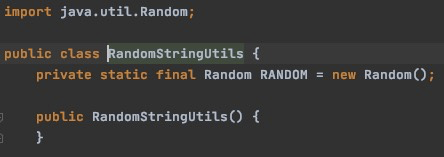先说结论
试测数据:
- 基于常见场景:在一个数据范围区间内生成随机数。
- 1000万的随机数范围,for循环生成50万个随机数。无其他额外操作。
| SDK包 | 性能耗时 | 评价 |
|---|---|---|
| java.util.Random | 9毫秒 | 1、编写简单,方法较多,也快速。很多SDK包都基于此扩展。 2、随机性重度依赖seed的情况,seed一样,分配的随机数和顺序一样。 3、线程不安全。 |
| ThreadLocalRandom | 8毫秒 | 1、继承于java.util.Random 2、与线程绑定,一个线程一个,多线程下安全。 3、seed情况部分借助于线程的内存地址等随机信息,来提升随机性。 |
| Math.Random | 14毫秒 | 1、用法上比较费劲,只能生成double。 2、内部有借用java.util.Random |
| SecureRandom | 142毫秒 | 线程安全,seed不可预测(借助于系统中的随机事件信息) |
| Apache#RandomDataGenerator | 54毫秒 | API比较丰富,特殊场景下考虑。 |
| it.unimi.dsi#XoRoShiRo128PlusRandom | 17毫秒 | 偏门的三方包。比较快。线程不安全。 |
1. Math.random() 静态方法
产生的随机数是 0 - 1 之间的一个 double,即 0 <= random <= 1。
使用:
1 | for (int i = 0; i < 10; i++) { |
结果:1
2
3
4
5
6
7
8
9
100.3598613895606426
0.2666778145365811
0.25090731064243355
0.011064998061666276
0.600686228175639
0.9084006027629496
0.12700524654847833
0.6084605849069343
0.7290804782514261
0.9923831908303121
实现原理:
When this method is first called, it creates a single new pseudorandom-number generator, exactly as if by the expression new java.util.Random() This new pseudorandom-number generator is used thereafter for all calls to this method and is used nowhere else.
当第一次调用 Math.random() 方法时,自动创建了一个伪随机数生成器,实际上用的是 new java.util.Random()。当接下来继续调用 Math.random() 方法时,就会使用这个新的伪随机数生成器。
源码如下:1
2
3
4
5
6
7
8
9
10public static double random() {
Random rnd = randomNumberGenerator;
if (rnd == null) rnd = initRNG(); // 第一次调用,创建一个伪随机数生成器
return rnd.nextDouble();
}
private static synchronized Random initRNG() {
Random rnd = randomNumberGenerator;
return (rnd == null) ? (randomNumberGenerator = new Random()) : rnd; // 实际上用的是new java.util.Random()
}
initRNG() 方法是 synchronized 的,因此在多线程情况下,只有一个线程会负责创建伪随机数生成器(使用当前时间作为种子),其他线程则利用该伪随机数生成器产生随机数。Java生成随机数的几种高级用法,这篇推荐看一下。
因此 Math.random() 方法是线程安全的。
什么情况下随机数的生成线程不安全?
- 线程1在第一次调用 random() 时产生一个生成器 generator1,使用当前时间作为种子。
- 线程2在第一次调用 random() 时产生一个生成器 generator2,使用当前时间作为种子。
- 碰巧 generator1 和 generator2 使用相同的种子,导致 generator1 以后产生的随机数每次都和 generator2 以后产生的随机数相同。
什么情况下随机数的生成线程安全?: Math.random() 静态方法使用
- 线程1在第一次调用 random() 时产生一个生成器 generator1,使用当前时间作为种子。
- 线程2在第一次调用 random() 时发现已经有一个生成器 generator1,则直接使用生成器 generator1。
1 | public class JavaRandom { |
结果:1
2
3
4Thread-1: 0.8043581595645333
Thread-0: 0.9338269554390357
Thread-1: 0.5571569413128877
Thread-0: 0.37484586843392464
2. java.util.Random 工具类
基本算法:linear congruential pseudorandom number generator (LGC) 线性同余法伪随机数生成器缺点:
可预测
使用:
1 | Random random = new Random(); |
结果:1
2
3
4
5-24520987
-96094681
-952622427
300260419
1489256498
Random类默认使用当前系统时钟作为种子:
1 | public Random() { |
Random类提供的方法:API
nextBoolean()- 返回均匀分布的 true 或者 falsenextBytes(byte[] bytes)nextDouble()- 返回 0.0 到 1.0 之间的均匀分布的 doublenextFloat()- 返回 0.0 到 1.0 之间的均匀分布的 floatnextGaussian()- 返回 0.0 到 1.0 之间的高斯分布(即正态分布)的 doublenextInt()- 返回均匀分布的 intnextInt(int n)- 返回 0 到 n 之间的均匀分布的 int (包括 0,不包括 n)nextLong()- 返回均匀分布的 longsetSeed(long seed)- 设置种子
只要种子一样,产生的随机数也一样: 因为种子确定,随机数算法也确定,因此输出是确定的!
1 | Random random1 = new Random(10000); |
结果:1
2
3
4
5-498702880 = -498702880
-858606152 = -858606152
1942818232 = 1942818232
-1044940345 = -1044940345
1588429001 = 1588429001
3. java.util.concurrent.ThreadLocalRandom 工具类
ThreadLocalRandom 是 JDK 7 之后提供,也是继承至 java.util.Random。
1 | private static final ThreadLocal<ThreadLocalRandom> localRandom = |
每一个线程有一个独立的随机数生成器,用于并发产生随机数,能够解决多个线程发生的竞争争夺。效率更高!
ThreadLocalRandom 不是直接用 new 实例化,而是第一次使用其静态方法 current() 得到 ThreadLocal
使用:1
2
3
4
5
6
7
8
9
10
11
12
13public class JavaRandom {
public static void main(String args[]) {
new MyThread().start();
new MyThread().start();
}
}
class MyThread extends Thread {
public void run() {
for (int i = 0; i < 2; i++) {
System.out.println(Thread.currentThread().getName() + ": " + ThreadLocalRandom.current().nextDouble());
}
}
}
结果:1
2
3
4Thread-0: 0.13267085355389086
Thread-1: 0.1138484950410098
Thread-0: 0.17187774671469858
Thread-1: 0.9305225910262372
4. java.Security.SecureRandom
也是继承至 java.util.Random。
Instances of java.util.Random are not cryptographically secure. Consider instead using SecureRandom to get a cryptographically secure pseudo-random number generator for use by security-sensitive applications.SecureRandom takes Random Data from your os (they can be interval between keystrokes etc - most os collect these data store them in files - /dev/random and /dev/urandom in case of linux/solaris) and uses that as the seed.
操作系统收集了一些随机事件,比如鼠标点击,键盘点击等等,SecureRandom 使用这些随机事件作为种子。
SecureRandom 提供加密的强随机数生成器 (RNG),要求种子必须是不可预知的,产生非确定性输出。SecureRandom 也提供了与实现无关的算法,因此,调用方(应用程序代码)会请求特定的 RNG 算法并将它传回到该算法的 SecureRandom 对象中。
- 如果仅指定算法名称,如下所示:SecureRandom random = SecureRandom.getInstance(“SHA1PRNG”);
- 如果既指定了算法名称又指定了包提供程序,如下所示:SecureRandom random = SecureRandom.getInstance(“SHA1PRNG”, “SUN”);
使用:
1 | SecureRandom random1 = SecureRandom.getInstance("SHA1PRNG"); |
结果:1
2
3
4
5704046703 != 2117229935
60819811 != 107252259
425075610 != -295395347
682299589 != -1637998900
-1147654329 != 1418666937
5. 随机字符串
可以使用 Apache Commons-Lang 包中的 RandomStringUtils 类。Maven 依赖如下:
1 | <dependency> |
示例:
1 | public class RandomStringDemo { |
RandomStringUtils 类的实现上也是依赖了 java.util.Random 工具类:
RandomStringUtils 类的定义
